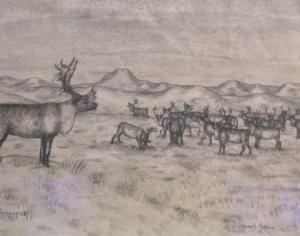|
George Aden Ahgupuk, whose Native
name was Twok meaning "man", was born on October 8, 1911
in the Inupiat Native village of Shishmaref, Alaska,
which is located in the Bering Sea approximately 90
nautical miles East of Russia. George spent the early
years of his life learning subsistence living skills,
such as fishing and hunting, from his parents and
village relatives. During the Winter of 1930, while
hunting for ptarmigan George slipped on an icy area and
broke his leg. Although his leg mended, it had not
mended properly and in 1934 he developed a Tubercular
infection that put him in the Kotzebue Hospital for
treatment. This was the start of a new life for George.
During his several months in the hospital, Twok doodled
and sketched the scenes from his village life. Having no
artist paper, these first works of art were on toilet
paper! One of George's nurses noticed his talent, and
presented George with drawing paper, requesting that he
make her some Christmas cards. With the money that he
earned from these cards, he returned to the village
realizing the potential to earn a living doing what he
loved, drawing. Without access to paper or drawing
supplies, he asked his mother for animal hides to draw
on. Seal skin was the first medium, and became one of
his trademarks.
Twok developed his own technique for bleaching
caribou/reindeer and moose hides. George was very
protective of his bleaching secrets and shared his
techniques with no one, not even his closest friends or
relatives. His artwork depicted scenes of village life,
seal and walrus hunting, polar bear hunting, whale
hunting, and Alaska scenery and wildlife.
George's life was a commingling of two worlds, his
Inupiaq lifestyle and the "White man's" lifestyle.
During the fishing season, he worked a commercial
fisherman to earn a living for his family. In the Winter
months, he would draw as much as possible to have
artwork to sell to the fair weather tourists. As a
traditional Eskimo, he used all of the resources
available to him. He not only drew on hides and paper,
but also on fish skins, seal skins, tree mushrooms,
plywood, ceramic tile, etc. Basically, anything that had
a surface that would hold paint could wind up in his
painting room.
In 1937 George's artwork was featured in an article
published by Mr. Rockwell Kent in the New York Times.
Through years of correspondence, a friendship developed
between the two, which opened many avenues for George's
artwork. Mr. Kent urged George to illustrate Christmas
cards. Other commercial projects developed later,
including illustrating a book entitled Alaskan Igloo
Tales by Edward L. Keithahn, The Last Frontier, a short
history of Alaska by Ben Adams, and I Am Eskimo, Aknik
my name by Paul Green and Abbe Abbott.
Until the late 1960's, George primarily sold original
works of art to tourists visiting Alaska, but with the
dawn of commercially produced souvenirs, George sold his
work for use on Alaska souvenir plates, cups and
saucers, lamp shades, placemats, napkin holders and the
like.
As a result of several strokes late in his life, Twok
had difficulty painting and drawing. However, his
intellect and will were still strong, as was his desire
to continue to document the earlier lifestyle of the
Alaska Native. Future generations will know Alaska
through his artwork. George Twok Aden Ahgupuk died April
01, 2001 in his home in Alaska.
Johnny Aculiak|
Edwin Tappan Adney|
George Twok Aden Ahgupuk|
Alvin Eli Amason|
Saradell Ard|
Belmore Browne|
Vincent Colyer|
Jules Bernard Dahlager|
Lockwood De Forest|
Frederick Samuel
Dellenbaugh| William
Franklin Draper| | Henry
Wood Elliott| John
Fehringer| Claire Fejes|
Louis Agassiz Fuertes|
Magnus Colcord Heurlin|
Norman Jackson|
Rockwell Kent|
Sydney Mortimer Laurence|
Fred Machetanz|
Marvin Mangus|
Milo Minock|
James Kivetoruk
Moses| Rie Munoz|
Joseph Henry Sharp|
James Everett Stuart|
John Webber|
Kesler Woodward
|




